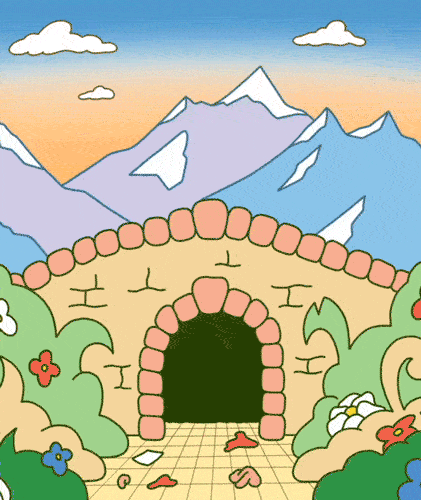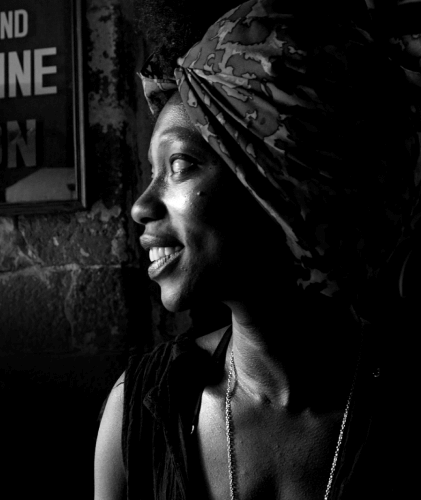Author: haris
Utilitario Mexicano
Talking craft and commerce with CDMX’s Utilitario Mexicano
Utilitario Mexicano is a must visit for anyone going to CDMX. Their mix of incredible objects from Mexican craftsmen paired with a beautifully spartan store just ticks a lot of boxes for us. Through them we’ve learnt some important lessons. Uno - always keep a molcajete to hand in the kitchen. Dos - don’t be afraid to break some rules! And luckily for us we now proud stockiest of some key Utilitario Mexicano pieces, so we carry on our Mexico City fantasies even back home.
Published 28/10/2020

DK
Who are the people behind Utilitario Mexicano?
UM
Husband and wife Enrique Arellano and Libia Moreno.
DK
I think I read somewhere that you guys are Colombian – please correct me if I´m wrong! How did your love affair with México start?
UM
Yes! We are Colombians, living half our lives in Mexico City (19 years now) This city has a magnetism that is difficult to escape from. It can also repel you. Once you get used to all the caos, you start seeing beauty in layers. Is playful and full of colors. Mexican markets are the best on our way of view in the world.
We used to live in downtown, Utilitario started those days, walking around the neighborhood, getting lost and wondering around every shop and corner, we always came home with something, we start collecting things, downtown is a huge open sky shopping mall, full of beautiful historic buildings everywhere. The blocks are dedicated to selling one thing for example electronics (Victoria street) then you walk two more blocks and you find disco balls, instruments and huge speakers for sonideros (Bolivar street).
And last but not least you have tacos and mezcal. Food is the master key that open the multiverses melted in this epic culture. Markets, people, culture, crafts, utensils, artisans, kitchens, ingredients, colors, flavors, music, stories, flowers, faith, traditions, mysticism, humor … and so on.
How come you are not going to love this city?

Photos by Joaquin Trujillo.
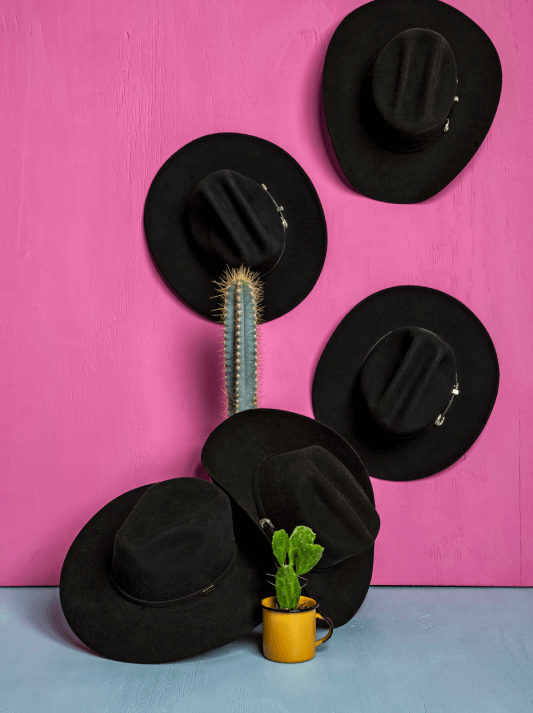
DK
We love that the store is simultaneously playful yet utilitarian. How did you create this mix?
UM
The space was full of trash and dark in all senses when we move in. We wanted the opposite, that is why we choose white, also it will serve us as a plain canvas to play with all the colorful objects we have in our catalogue. We want to bring the basics of warehouse with the metal racks and the pegboard, a utilitarian display for utilitarian objects.
It turned out to be fun because everything was done with our own hands, so keeping it simple, quick to build and inexpensive were the mandatory conditions. In the process a lot of the garbage, wood and iron waste that was left in the location ended up at the store front. Recycling became an organic part of the project and a signature of the store.


DK
What did you guys do before starting the store?
UM
Enrique:I have worked as graphic designer for advertising and branding for many years, but one day I got really tired and start working as a freelancer in projects that move me, and Utilitario came as a project that stay and became my work, our creation.
Libia:I have another brand call Colorindio, we work with artisans co-creating traditional textiles for home decoration. I had this obsession with a little store in downtown that no longer exist, and wanted to replicate something like that, the store had all kind of cotton ropes, natural fibers, basics for the house. We try to make it in a way no one can resist on taking something that they will eventually use.
DK
Tell us about the neighbourhood that the shop is in. Your location is quite unassuming which brings with it such a charm
UM
La Juarez, was a wealthy neigbourhood in the late XIX century, many of the mansions are already under ground by the earthquakes and others are only facades with no roofs on top. Still have this charm of local living with a market near by. For us choosing the space was more because it had some of the things we were looking to express in a better way our vision of Utilitarian objects, is huge and is in the middle of the hip zones and our always inspirational downtown.
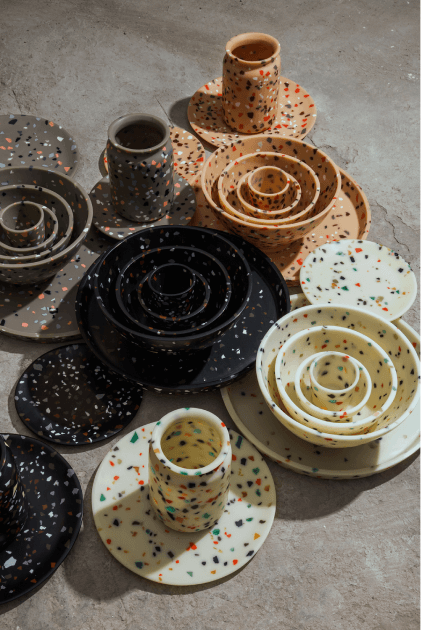
Pepita collection. Photo by Ana Lorenzana.


DK
What does #hechoenmexico mean for the future?
UM
We think this is something that not only applies for Mexico #hechoen… is the way consumers are buying from their near stores and business. Now, these days under the present circumstances, local movement can make the difference in a nation like Mexico. It takes a lot of change to make this happen by start recognizing the economic benefits on your block, neighborhood, city and community and consequently avoid the trap or belief that because is local it’s needs to be cheaper than all others.
DK
Are there up and coming crafts? Equally are there any crafts in need of saving?
UM
México is a big country and almost everywhere you go there is handcraft made. Is Rich in culture, many artisans are organized in cooperatives and they have been evolving with the way they produce, of course with the boom about artisanal design many of them have open to new customers and markets, internet have been a really good way of promoting their work. And with the tendency of working in communities there is an interest in young people of learning the family crafstment heritage.
DK
Are there any stereotypes about Mexican design you would like to change?
UM
Nothing to change. Everything in México has a meaning, even when it becomes a cliché still have his charm. The range of color combinations for example would not be possible if anyone tries to design within an academic or theoric frame. Mexican designs can break so many rules! that that is why they are always surprising and innovate. It contains a huge dose of knowledge and ingenuity.
What we have found extremely difficult to achieve is reaching production scales in the order of tens of thousands units. Factories with industrial capacity do not tend to leave their comfort zone. Designing and producing using the infrastructure of small and medium industry is only possible in the order of hundreds at best, so growing is a difficult fish to catch.
DK
Is there a kitchen gadget you cannot live without?
UM
Lemon squeezer / Libia. Molcajete / Enrique
DK
Do you have something in the range that you are especially excited about right now?
UM
Pepita collection.
Utilitario Mexicano can be found on IG here
Published 28/10/2020
By DK Woon
Photo credits Joaquin Trujillo, Erik Lopez, Ana Lorenzana
Selly Raby Kane
The Selliest
Selly Raby Kane’s showroom and studio occupies a three-story building on a quiet street in the center of Dakar. It’s dusty season, when the harmattan wind from the Sahara fills the city with fine sand. Kane wears her updated take on the traditional “bou-bou”, star-shaped mirrored glasses and a silver sequin face mask. Not for protection against the elements, just as a matter of style.
Published 27/10/2020
CF
What do you say when people ask: “What do you do ?”
SRK
I talk about what takes most of my time, which would be fashion. And then what I aspire to do, which would be film, and the arts. Then you have design as a whole and different collaboration projects, like the development of Muus Du Tux, the collective of creatives that I share my space and thoughts with.
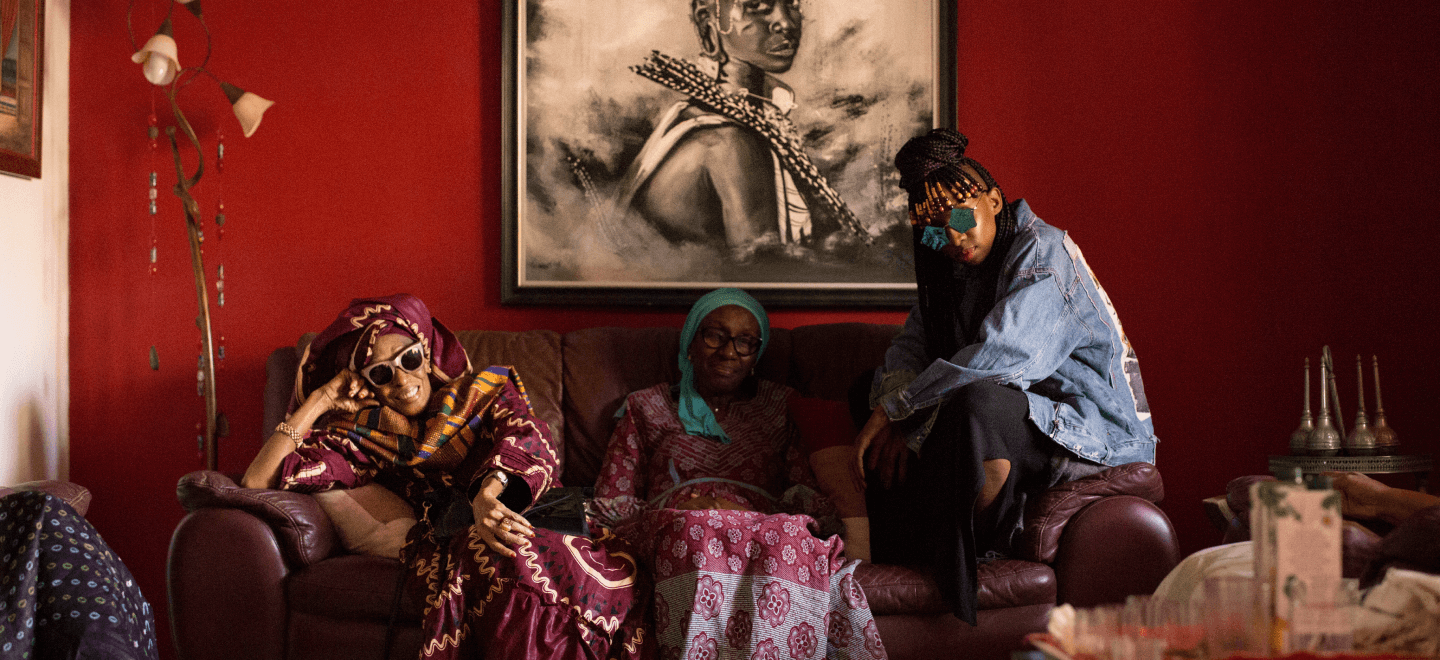
Three generations of Kane
«My grandmother has always been one of my biggest influences. At 80 years old she is still a fashion icon.»
CF
Are you comfortable with calling yourself an artist ?
SRK
Not yet. Maybe when I can dive further into film making, and have more opportunities to express myself without having to mind the day-to-day production of running a fashion brand – which requires a very commercial mindset. Maybe then I will feel at ease calling myself an artist!
Collaboration is important to Kane who views fashion as a force for change. She follow in the footsteps of late Senegalese artist Joe Ouakam and filmmaker Diop Mambéte, founders of Laboratoire Agit’Art, a disruptive and rebellious collective that started in the early 1970s. One of Kane’s recent collections, “17 Rue Jules Ferry”, was named after the location of Ouakam’s backyard in Downtown Dakar, where the artists would come together.
CF
Are there similarities between what Muus Du Tux are doing and what Oukam and Diop did in the 1970s ?
SRK
Absolutely. They formed a group of super creative individuals who broke boundaries and completely shifted the meaning of creating art in Senegal. They set fire to everything that had been put into the heads of artists back then. Showing the world that, for example, junk art was art, that formats needed to change, and that white galleries did not have a monopoly on art and beauty. Now, we are entering a new cycle. That’s how time works. This is our cycle, our fight. And we have tools that other generations didn’t have, not least new technologies.
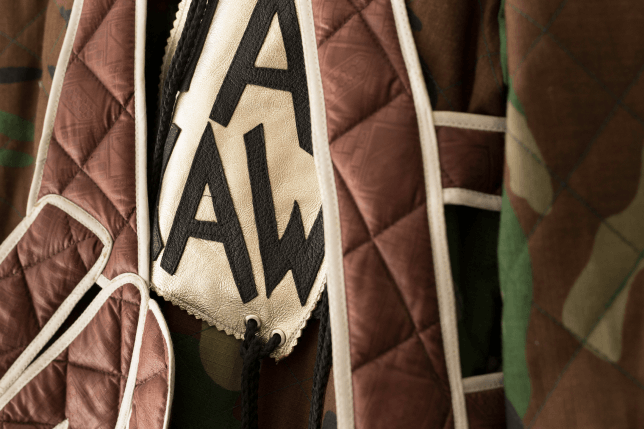
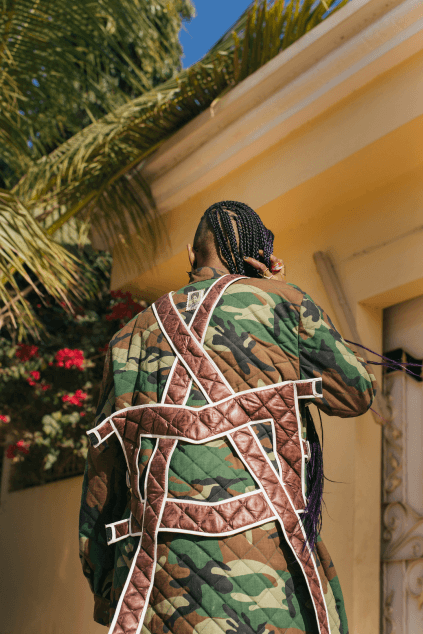
CF
Yesterday we sat down with your grandmother, mother and aunties, and you asked them about their fashion history for the first time ?
SRK
Yes! I guess it’s been too close to home. My grandmother has always been one of my biggest influences. At 80 years old she is still a fashion icon, always dressing up, with a different tailor for each silhouette. But yesterday I learned that all the women in my family were obsessed with fashion, and with maintaining their status and expressing themselves through their garments. I was interested to hear about the road we’ve traveled as Senegalese women, from the time they were young until today. For some time, they didn’t want to wear traditional clothing – that was the mindset here before independence. For me, it’s liberating to wear it. Our conversation made me think about how quickly change can happen, and that things are always in motion. If you can act as an accelerator, that’s great. Times will change anyhow, because that’s just how it works.
SRK
I started in fashion at a moment when my father was tired of his world, and had a choice to do whatever he wanted to. I also think, because his parents didn’t support his creative side, he wanted to support mine.

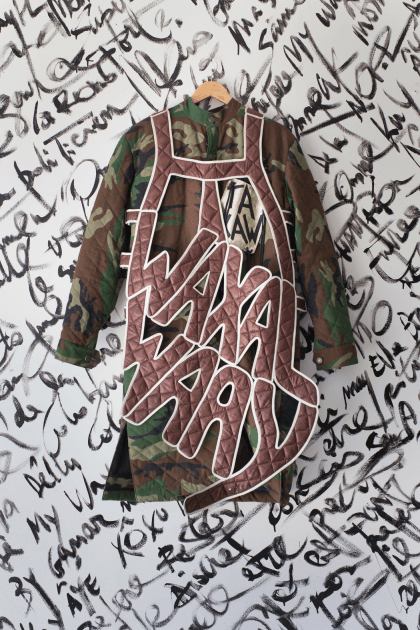
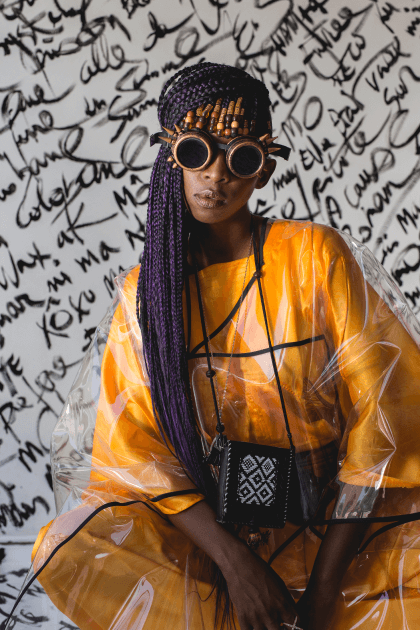
CF
In another universe, if his parents had been more like yours… ?
SRK
… he would have been a jazzman. Free jazz, playing the guitar and harmonica – for sure!
CF
In your late teens you chose to study political science in Dakar ? Why was that ?
SRK
Before I turned eight, I already knew I wanted to be a designer. I used to sow by hand, dressing dolls, always annoying the neighborhood tailors. Then, mostly by chance, I became a child rights activist. Between 8 and 17 I was hosting a radio show for kids, interviewing Kofi Annan and representing Senegal in the UN, stuff like that. At that age, having a voice, being able to express my opinion and knowing that people were listening to me, it was precious, and it impacted my choices.
«When I arrived in France in 2004, it was the first time I realized that there are differences amongst people.»
CF
Was it always your intention to become an independent entrepreneur ?
SRK
I always knew I would be on my own. And that I would need to know as much as possible about the industry – about sourcing and distribution – the business of creating products and making them available to many people. Mod Spé taught me about textile technology and industrial production, tools that I am still using today. But it was not primarily about academics for me. I came to Paris at the time of a cultural shift, when art and culture was exploding. It was a culture shock to me, which helped unlock something deep down inside. I was able to understand what my creative language was, rooted in the influences that I had absorbed during childhood in Dakar. It was already in me, but it didn’t show in my garments yet.
CF
Did you ever consider staying in Europe after graduation ?
SRK
I always knew that Dakar was where I could express myself and interact with people in peace. When I first arrived in France in 2004, it was the first time I realized that there are differences amongst people. One example: I was waiting to cross the street. There was a big lady next to me, her bag was on my side. She looked at me, took the bag and shifted it to the other side. I suddenly realized that to her, I was “the other”. I had never experienced anything like that before. So, I had to reflect – what can situations like these create inside of you? What can they imprint on your psyche? Did I want to live in a country where I had to deal with this every day? Was this where I saw myself thrive? No.


CF
How did you get started when you returned home ?
SRK
I was already part of Petit Pierre, a collective of creatives in Dakar. In 2013, we organized “Be Street,” a huge fashion show inspired by urban arts across Africa and globally. It was a massive immersive installation, mirroring urban scenes of Dakar in a surreal way. Street vendors mixed with dancers, shoe makers and poets, and a fashion show in the middle of that. We wanted to bring the magic of Dakar’s aesthetic and style into the future and see what would happen. It had a very different approach from what Senegalese fashion shows were back then, and gave us a lot of exposure.


SRK Showroom, interior and exterior

CF
You view the founder of the Petit Pierre Collective, Cheikha Loum, as your mentor ?
SRK
True, though he would never say he is anyone’s mentor! He was the one who gave me the idea of transferring the stories I used to write in my head, about my collections, into actual writing. And I became addicted to that. Working with my collections, I start out with a vague mood or direction, and write a story inspired by that. Once the narrative is written, sometimes with characters, dates and locations, it carries with it the intention of the collection. I translate that it into a huge mood board where I include as much as possible; words and images, so that people can know precisely what I am talking about. I only start drawing once the narrative is done. Also, working on the collections or fashion shows, I always collaborate with a beat maker, a producer, or just a musician who can translate the collection into a signature sound. In my personal creative process, I gravitate towards experimental music. It helps me connect with something deeper, it’s like an accelerator. I’d like to start making music actually. It could be interesting to create sound together with the garments, a story that blends many worlds.
Kane, like many of her peers in the new wave of African fashion designers, experiments with mixing international influences with traditional elements and silhouettes. Lately, she has learned to work with niahaas, the intricate patchwork technique used by the Baye Fall, a Sufi order that Kane likens to the urban tribes and subcultures she encountered in Europe, but with a spiritual base. The Baye Fall are known for their unique garments, the patchwork originally developed by sewing together salvaged or donated fabric scraps. The philosophy of these community based groups fits well with Kane’s own focus on social responsibility and sustainability, or as she has put it “opulence through frugality”.
SRK
Nothing has sparked my curiosity and app-roach to life and fashion as much as the Baye Falls. They are the only ones in Senegal who’ve historically challenged social codes, expressing individuality and freedom. And they dress in that exact spirit, with complex and creative ways of expressing their identities, their beliefs and ways of relating to eachother and society at large. The dress codes, the accessories, the readings and philosophy, everything that one connects to a subculture is pretty much there. You also have different factions of Baye Falls with different styles. The black and whites are not the same as the red and blacks etc. Most interesting to me is the Mouride brotherhood, founded by Amadou Bamba in the holy city of Touba. He was obviously an important spiritual figure and involved in the anti-colonial fight. But he also created this trend, a mindset and a style that contributes to the Mouride being the fastest growing brotherhood in Senegal today. I’m curious about that part of our heritage. The lifestyle, and the way of dressing are as important to document and draw inspiration from, as is other parts of our heritage. I have a very specific way to approach that, and that’s precious.
«As Senegalese youth, we are not waiting for the patrimony to arrive, or for others to decide what we are to do.»
CF
How do you go about “digging” into these archives ?
SRK
So far, I’m on a superficial level. I read a lot and study talismanic writings, and the art of healing in Senegal. I’m realizing that there is a misconception of modernity in my country.I think our politicians too often feel that modernity is looking and doing like Paris or Dubai. But it’s not that at all. African modernity is not about going to Dubai to buy all your furniture and bring it back here. It’s about looking at what we have, how it adapts to our time now, and keep what is useful in order to create a better environment and better lives for people. I don’t think we dig deep enough into our patrimony. It is happening in some layers of Dakar, but not in what’s actually being built, such as in houses, roads and infrastructure. That is unfortunate.
CF
Will the younger generation make it happen ?
SRK
Absolutely. How mainstream it is going to be remains to be seen; how people are going to shift their approach to what being cool is; what being rich is. It’s an ongoing conversation. As Senegalese youth, we are not waiting patiently for the patrimony to arrive, or for others to decide what we are to do.


CF
The debate surrounding heritage, patrimony and, for example, reclaiming of stolen art from the continent was fueled recently when the new Museum of Black Civilization opened in Dakar. Have you been ?
SRK
Yes, and it’s an important space. It was super moving to enter the main hall and see all the skulls and bones, millions of years old. And objects connected to our national icons, that we’ve only known from school books, like books, shoes, clothing and weapons … It made them seem more human, less legend, more touchable. The fact that objects are coming back is excellent. But what it will create inside of us is the most important thing. That discussion started long before the objects started to arrive. How can we use these objects to create and activate a conversation amongst people. I definitely don’t think that museums will be the only spaces where the patrimony will be used or stored.
SRK
We are using all tools available to us, from technology, scenography, sound immersion and VR. Anything that can reach deeper into human beings than policy and curricula can. I feel that the moment is here for a deep shift in people’s mindsets, and that arts, culture, and design is the way to make that shift happen. You can see and feel it happening here in Dakar and on the continent. One of our upcoming projects is Estrogen, a publication and a platform for radical creative women who want to be able to express themselves without having make concessions or adapt to anyone or anything. A space for abundance, for maximalism and radicality. In Senegal, if you think or act in a slightly different way, you can be labeled plain crazy. I hope Estrogen will open doors for a lot of crazy people.
CF
It seems important for you to open doors ?
SRK
A brilliant man, one of my elders, told me this: You don’t have to mobilize a huge group of people. You only need to open a door, through your work, your statements, your unique voice. Eventually, tomorrow or in a couple of years, it will become what it must become, when it’s time for people to enter that world, at their own pace. I think this is a time of reconnection, a time of pure appreciation of what we have and how it can bring us into the future. And once the door is open, it cannot be closed.
Published 27/10/2020
By Carmilla Floyd
Photo credits Petorovsky
Lun La Lame
Interwoven. Juxtapositioned. Superimposed.
It is early morning in the city of Dakar and a “buju man” is roaming its streets. Making holes in the walls, free-ing the skeletons of the city. He has been many things and may yet become many more but right now he is a plastician, working with what the city gives him. Which, in his case, are the bright and colourful PVC tubes used in housebuilding. Meet Alioune Samb or Lun La Lame as he prefers to call himself.
Published 25/10/2020
High atop a building in the Sacré Coeur area of Dakar rests what looks like the head of a giant bird, completely made out of multi coloured PVC tubes.
The house is the base of operations for designer Selly Raby Kane and art collective Muus Du Tux, cat’s don’t smoke, and it’s roof is filled with the wildest art. Under the merciless sun we wander around signs, sculptures and other more undefinable structures surrounding a small sewing studio. Elevated above it all is the birds head, that we now realize also works as a nest. We climb a small, rickety ladder that takes us inside the colourful hideaway. It is cooler inside.
Slumped in a chair made out of the same PVC tubes as the rest of the nest/head, Lun La Lame greets us with a sly smile. It’s funny that you are from a magazine called Skewed, he says. Because when I built this, someone had to climb inside and test it, and it was I. And I climbed up and looked at it from the in-side. Tilting my head, looking, tilting my head, looking. And I was looking at it from a skewed perspective.
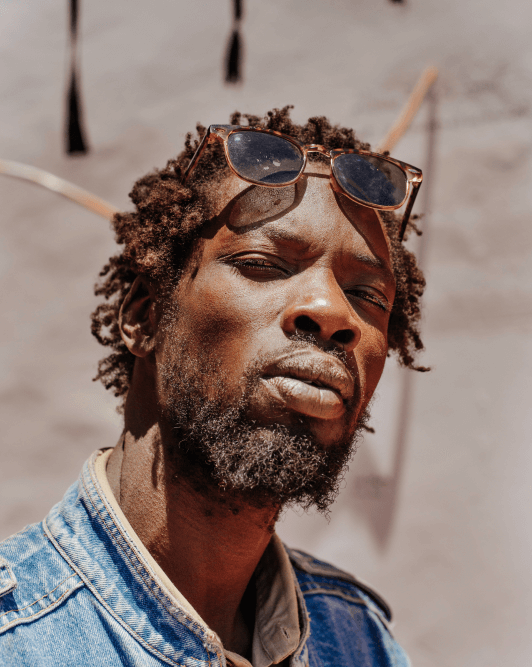
RU
Who are you ?
LL
I’m Alioune, like the friend of the prophet who got a blade from the sky that could cut a thousand people to the left and a thousand people to the right. A blade from the sky like when the moon, la lune, is a blade. My hands are blades and I cut things out of walls. Like these PVC tubes that I used to build this permanent workshop, this permanent working site, that we’re sitting in.
RU
Why do you work with PVC tubes ?
LL
It’s the material that keeps everything together. And I work based on an idea of unity. Of keeping things together, keeping the differences together. PVC tubes, PVC pipes. They are a construction inside a construction and I put them outside a construction. Interwoven, juxtapositioned, superimposed.
And it’s not just about beauty, but also being useful. With them I can build things that you can sit, sleep, eat, hide in. They are beautiful. It’s the bright chaos. The luminous chaos. But they are beautiful and true, and with true I mean functional. Because here in Dakar when beauty is not useful, people don’t care about it.
But they also have meaning. I was out of the world for a long time. I cut myself out of the world. I stayed hidden for a long time. But like the PVC being out of the wall, like me they are no longer hidden. It’s to say “Alioune is here now! I’m out!”
RU
How were you hidden ?
LL
I was a vagabond. I was a vagabond for a long time before art school and I still have no phone and I have no real home, but I am out in the world.
If you want to learn, be a vagabond. I learned as much, if not more, as in art school.I learned that the only thing that can cure a human is a human. That humans are the remedy for humans. That you can work for God through the human, serving God by serving the human.
And I met a lot of friends, different friends. Vagabond friends and sage friends. If you are a multidimensional being you can understand different people, all kinds of people.
But I also met a lot of fake, a whole lot of fake. They hurt me, hit me, they broke my nose, they even burned my ass. But it is ok. I learned from the fake. I know how you spot it. That is why my concern is on the true now. Because meeting the fake on my journeys made me stay in my lane, to stay the course that is only mine. Because if you travel in your lane, no matter what happens or who you meet, that is when you find your originality.


RU
How is art in Dakar ?
LL
It’s a struggle being an artist in Dakar and it will always be a struggle. You know, art is wicked. Art is generous but it is also unjust. Art is not fair in Dakar but art saves souls so you keep going. It’s in our spirits and it will bring us beyond the hardships and help us move forward. Like Shaka Zulu said: if you move forward you die, if you move backward you die. So you might as well move forward. And when your back is against the wall, you do not even have the choice to go backwards. Only forward. So that is what art is like in Dakar. Having your back against the wall.
«It’s the bright chaos. The luminous chaos. But they are beautiful and true.»
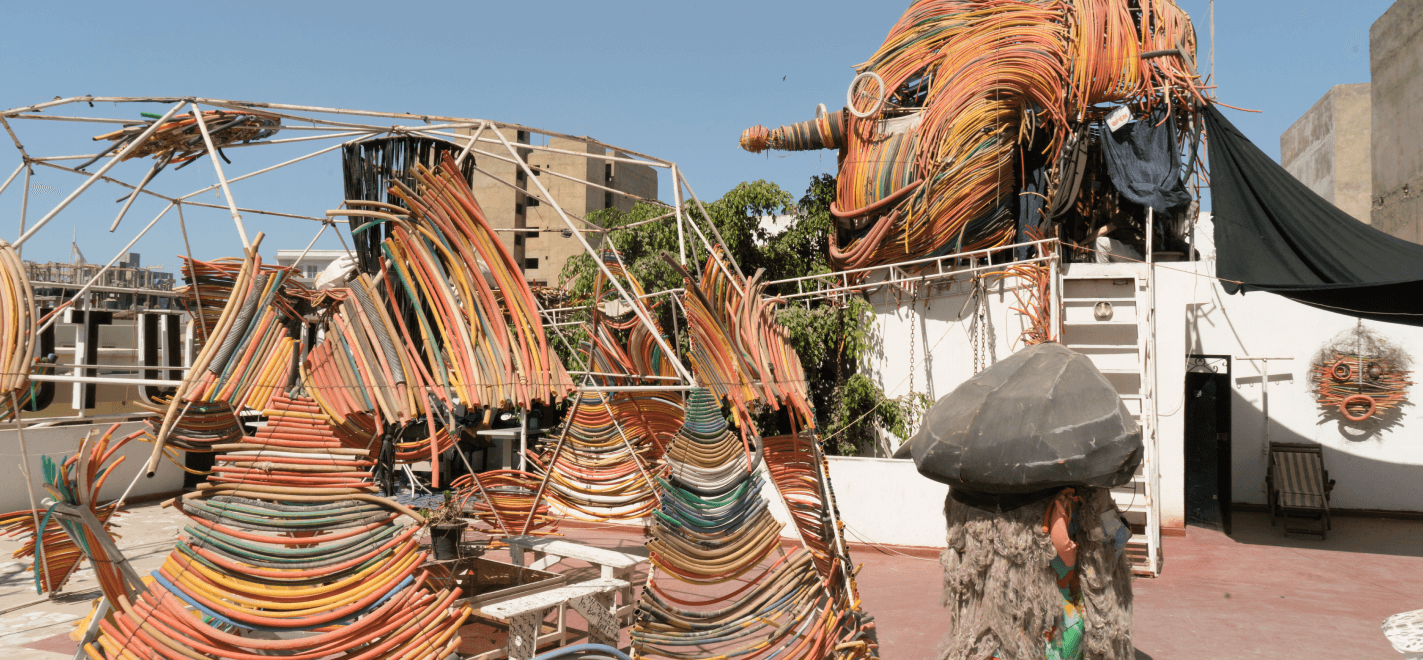
The rooftop at Muus Du Tuux
RU
How do you think your art would change if you were somewhere else ?
LL
If I were not in this sphere, I would be in another sphere. Maybe I will travel to another sphere, maybe it will be futuristic. But in different spheres there are different elements so I would weave in a different element than the PVC tubes. The secret to weaving in different elements is not in the elements, It’s in the weaving. It has to weft.
RU
Where do you think you’ll be in, say, two years ?
LL
I will be very difficult to catch in two years. If you come back here in two years, who knows? Maybe I will be hidden again. Maybe I will be inside a wall. Or maybe I will be too busy working for the divine to be caught. Maybe I have moved on to where thirsty souls go to drink, because I have been showed where that is. I know a higher form of art than art, a higher form of spirituality. That is why I cannot waste any time. Because I have tasted something that is way bigger than art. A food that is way more delicious than art. I am not running because I still have vagabond blood in me, I am running because I am being chased by death. And if I don’t get to that special place before I die, I will berestless in my grave. So, you know, the only way to find me in two years is to follow my tracks.
Time and time again during our conversation Alioune comes back to these spiritual musings. He is a man of faith and his faith is that of the Baye Fall. The Baye Fall is a sub-group of the Mouride, a sufi order prominent in Senegal. It’s fascinating how often the values, rituals and doctrines of the Baye Fall come up in conversation not just with Alioune, but with so many of the artists and creatives we meet during our stay in Dakar.
«Art is not fair in Dakar but art saves souls, so you keep going.»


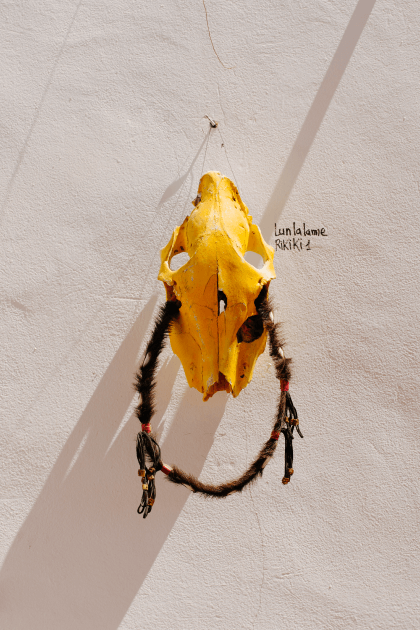
RU
What new projects are you thinking of ?
LL
To take my art to the streets and make a new kind of street art. Like this nest we’re sitting in, I would like to take this kind of structure to the streets. To give it as shelter to the women serving food on the streets, or for the kids running around town. To give them a zone of temporary independence. You know, I like pain.
He holds up his hands. They are rough. Marked by many years of digging through rubble and walls. Carrying his PVC tubes and other findings through town, burning and bending them to his will. These, he laughs, are the hands of a Buju Man, a garbage collector.
LL
like the hardship of creating. I like the untouched fields, the creation from virgin fields. And I like taking something from that and making things that help the people. My art is progressing by me putting wood in the PVC. Making them steady enough to even be in living rooms. But I am not in the money business, I am in the unicity of differences business. Using my art to help. I am constantly looking for tools to help more. And I know that I can’t help everyone, I understand that, but I will try. Like, I know this interview is over soon and I wonder, are you happy with the interview?
RU
Yes, very happy.
LL
See, I helped you.
Published 25/10/2020
By Rikard Uddenberg
Photo credits Petorovsky
Kaak Society
Born in a House of Art
Accessories tell stories. That’s why you don’t use the same accessories all the time. You chose what story you want to tell, and you chose what time to tell it. Ibe Sow, the brain, heart and hands behind Kaak Society, knows this better than most. That’s why his accessories tell the most captivating stories.
Published 14/10/2020
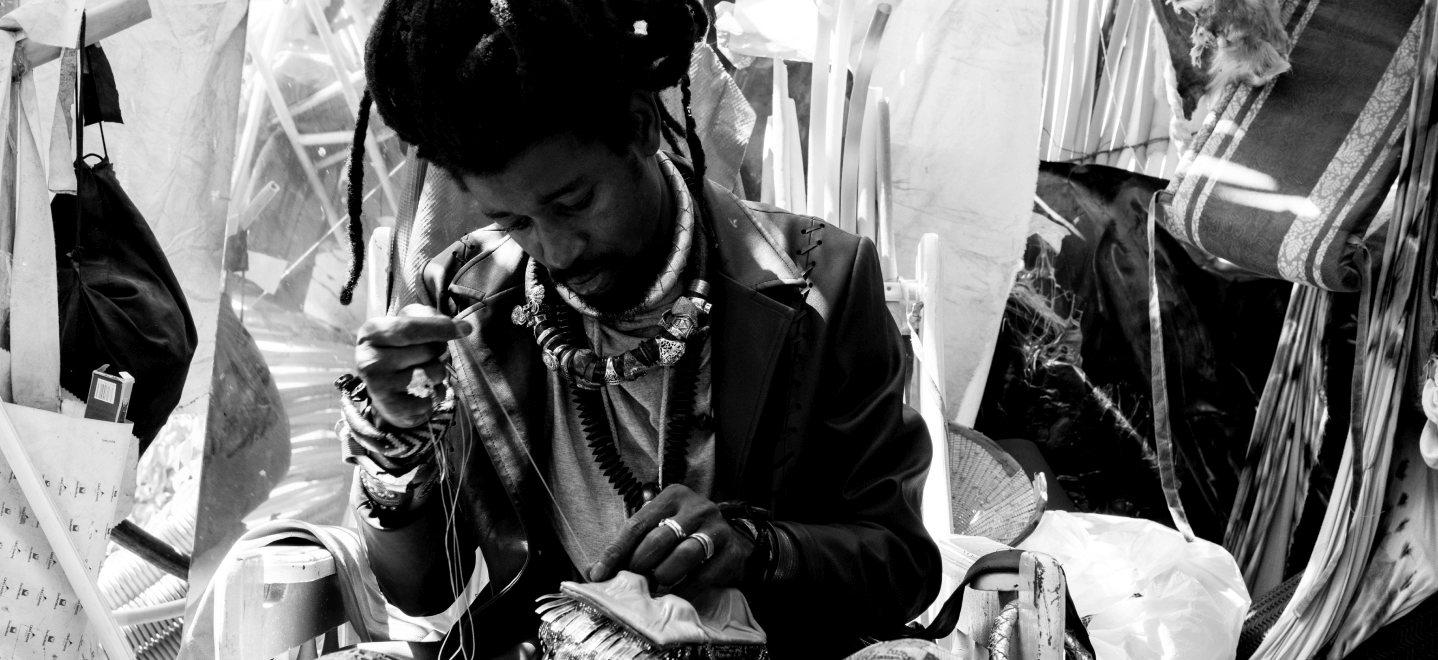
RU
How come you became an artisan ?
IS
I was born in a house of art. My father was an artist so I’m very used to people creating with their hands. I used to trip on instruments and tools when I was little. I was trained in woodworking and then switched to iron welding. But soon it was obvious that my profound love was accessories. My family was mouride, that’s the umbrella over the religious sect of Baye Fall, and I became a Kaak, a section of the Baye Fall. Accessories are a big part of our culture.
RU
Didn’t you want to rebel against your parents ?
IS
No, if anything, I pushed the curiosity even further. I have always had a great interest in culture, tradition, rituals, ceremonies and especially the artistic aspects of the ceremony. I have always been surrounded by art, be it music or dance or accessories. It is a deep interest in art that has a foundation in culture or ceremonies or identity.
RU
Other than tradition, what’s the inspiration for your bags ?
IS
I get inspiration from my surroundings, from what’s happening in the now. I look around and translate the reality into objects you can use. Some days ago, our electrical iron blew up, so we had to use our old traditional iron with charcoals in it. And I had forgotten what a beautiful object that was. So, this bag I’m working on now is inspired by an old traditional iron. And now, as we are speaking, I’m looking at your camera. Maybe my next bag will be inspired by a camera?

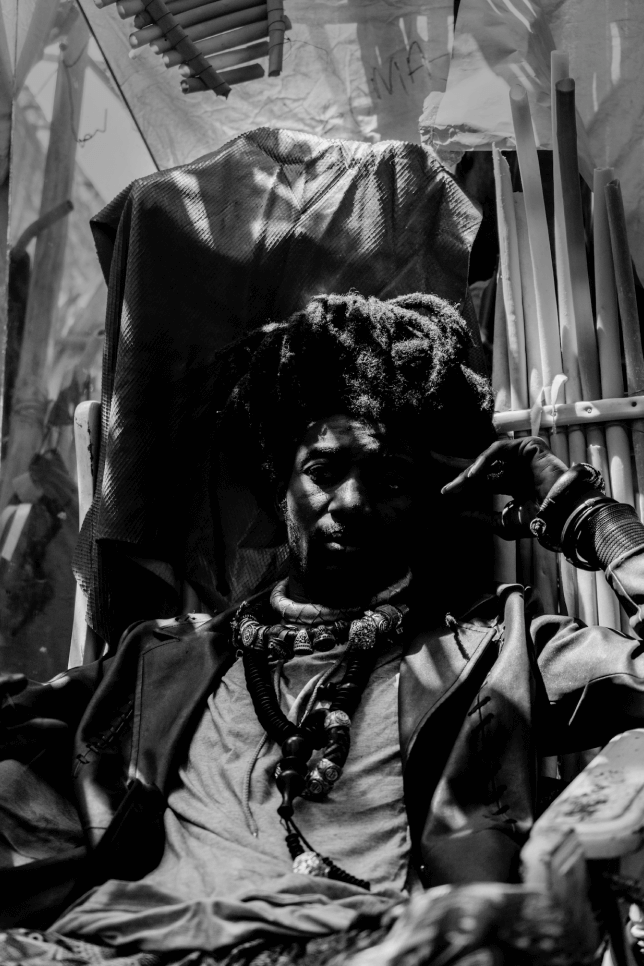
RU
How much is mapped out beforehand ?
IS
I’d say maybe 90%. I have a vision in my head before I start and I know how the material will answer, because I’m so used to it. But I’m open to life happening or someone having an opinion. Sometimes someone else from Muus du Tux walk in and a conversation occurover the bag and it changes it.
RU
Didn’t you want to rebel against your parents ?
IS
No, if anything, I pushed the curiosity even further. I have always had a great interest in culture, tradition, rituals, ceremonies and especially the artistic aspects of the ceremony. I have always been surrounded by art, be it music or dance or accessories. It is a deep interest in art that has a foundation in culture or ceremonies or identity.
«I’m looking at your camera. Maybe my next bag will be inspired by a camera.»
RU
This one, for example, is obviously based on an egg container. How did that come about ?
IS
One night I woke around 4AM because I heard some Baye Fall-chanting in my neighborhood, I walked over to witness and listen to the ceremonies. When I was walking home, I saw some egg containers in the trash. I started thinking, maybe I should do something with an egg container? Then, when I turned the corner, suddenly there was stacks and stacks of egg containers. I knew it was a sign. So, I took one of them home and started to speak to it, what will happen to you? And this happened. It’s named after the man who makes the best eggs in my neighborhood. So, the name of the bag is Ge.

RU
What’s a typical day in the life of Ibe ?
IS
If we’re talking about Kaak Society, it’s fairly easy. I finish one bag, come up with the idea for another one. I put up my tools and the material, making sure my idea will work, and then I start. I work fast. But apart from that I have a lot of social work. So, I live my life between creativity and society.
RU
Aren’t you worried to get swallowed up by the monster that is the fashion industry ?
IS
No. The culture and tradition that I draw inspiration from is way older and bigger than any brand or anything. It’s a culture and a mindset. That is not something that will live or die by trends.
RU
Are they more than accessories ?
IS
All accessories are more than accessories. They are pieces of art, and art is a statement you share. And the bags are bold, so they are bold statements. Some see the bags and think I’m crazy but others can see that they’re statements about the country and my specific subculture.
Published 14/10/2020
By Rikard Uddenberg
Photo credits Per Cromwell
Ami Weickaane
Paris-Dakar
Ami Weickaane, also known as Blu, has devoted her life to, in her own words, art, culture, environment, ecology, the holy feminine and the African intangible heritage. She’s also an African woman in Europe and a European woman in Africa. In the middle of it, yet in-between.
An instigator, and an observer. A creative, and a curator. She goes wherever her sensitivity takes her.
Published 14/10/2020
RU
How old where you when you left Dakar ?
AW
I was 19, maybe 20. It was the 90’s. I got the chance to go to Paris to study, to be one of the few people to leave Dakar and go to the outside. I came to Paris for my studies and I ended up staying for, I think, 20 or 22 years. My studies went very well, and I started working there in marketing, communication and promotion.
I had so many different lives. I used to be like a Parisian girl, always running, always working, always searching for some artistic stuff somewhere.

RU
And then, all of a sudden, you were back.
AW
Yes. I told my son and daughter, “You have to change your life now. We are going back to Senegal where your mum is from.” They didn’t know that much about this country. I came back to Senegal one year ago, and I reconnected with the people I had left when I was a child. I was so happy to find a lot of them being part of the great art energy in Dakar. Artists, activists, intellectuals. It was just like we had never been apart. So that was my first surprise going back to Dakar.
RU
What was the second surprise ?
AW
The second surprise was, maybe not as good. You know, my whole life in Paris I was claiming that I am an African woman, Senegalese from Dakar. And when I came back to Dakar, they were looking at me like, “You are from the West. You don’t know anything about Dakar and Senegal.” That’s a very strange energy, being in-between like that.
RU
What’s it like being back ?
AW
Being in Dakar, and living in my neighbourhood in Point E, bring me the possibility to see all the different shapes of this town, and what I was when I was there and what I amnow, and the whole change of the city. One thing I really love about the city is that people never ever give up. They are always trying to do something with their art, their music, their politics, their everything. They’re always searching for something. They’re always trying to find a solution even when there’s no problem.
RU
That’s a lovely quality.
AW
Yes! They’re seekers of everything. Whatever you ask people, everything is always possible. Everything is always doable. They never give up. So at least I’m recognizing myself in that as an African woman from Senegal. I had to struggle a lot in France, being a black, female business owner. I never give up.
RU
Has anything changed for the worse ?
AW
The mindset. When I left, to me, it seemed the people were very proud. Proud of what they were and proud of what they had. Now, not so much. They want something else, the dollar bill, a new car or organic food, without realizing everything we eat is organic. Also, the level of education. I think there’s less and less cultural knowledge in our education. Knowledge about ourselves and the world seem less important somehow.
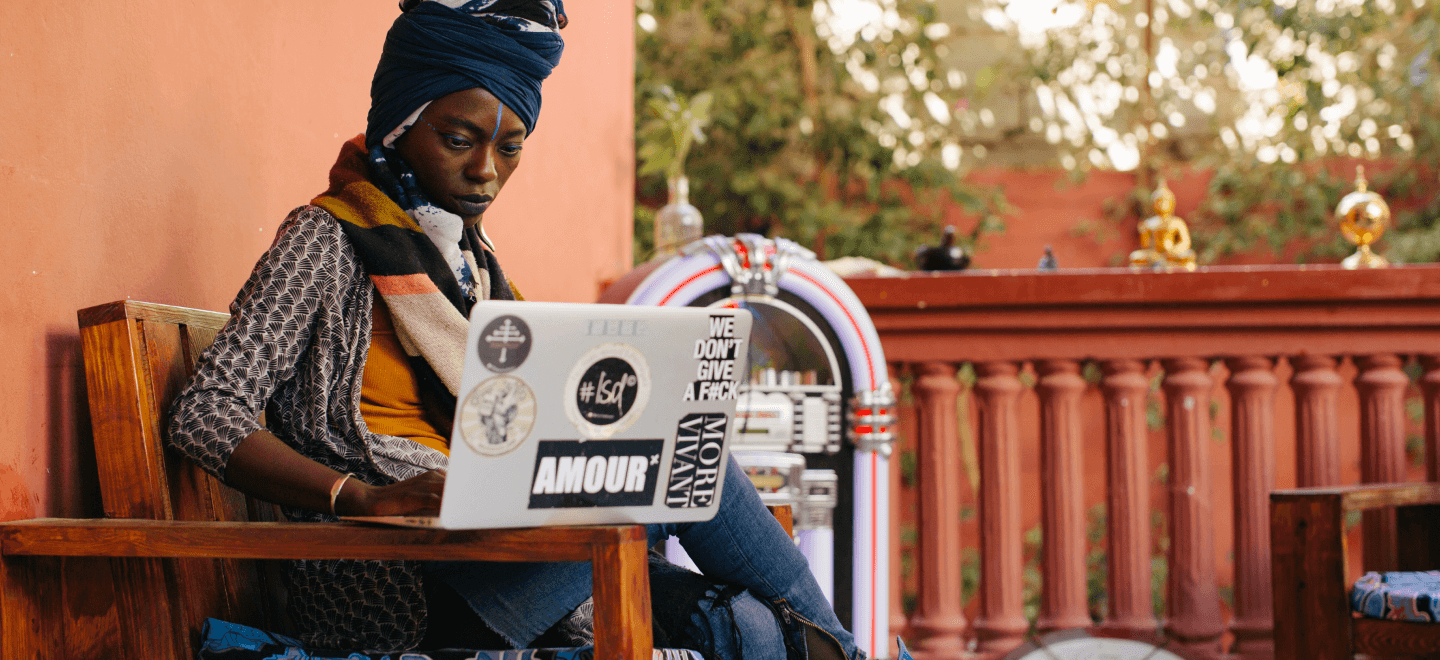
Ami on her porch in Point E
RU
That’s the internet, right ? We’re not happy with who we are because we’re looking at others all the time. And we don’t value knowledge because we think we got it in our phones.
AW
Exactly. We got Google and Wikipedia so we don’t need to know anything. But African people should really, really keep the know-ledge and know who they are, where they are from and where they are going.
RU
Let’s move to happier things, let’s talk more about art !
AW
No, this is not sad! It’s facts! And it’s facts that explain the art stuff. When heritage get less important in general society it shows up in the art. And the art truly is in our DNA. I love to just sit at the corner and look. The wrestlers going to the beach to train, the women carrying stuff on their heads walking to the market. The way they look, the way they move, the way they talk and the way they act – it’s already artistic. The girl working in my house, everyday she’s done some new art stuff with her shoes. It’s the artistic DNA showing. And art is healing. Having art is like having a healer. You can let your mind wander, you can dream and, also, it creates reach between people. That’s so important in a big city like Dakar.
RU
What’s your favourite spot in Dakar, geographically or spiritually ?
AW
My favourite place in Dakar doesn’t exist anymore because it was just a corner where we used to go after school and sit, inventing everything, the world we would like to have, the kind of life we would love to create. It was called Blockers, behind a big wall and in front of the ocean, but it’s gone now. Or maybe my favourite place in Dakar is on it’s way, because my big dream is to create it and I have some ideas in me.
RU
I’m sure you do. I know this is the worst question in the world, but I have to ask it. What are you? What is it that you do ?
AW
That’s the hardest question. Right now, I’m creating three exhibitions. I’m working on opening a place in Dakar and I’m writing a book. I’ve also started doing conferences around the world. Last week I was in Barcelona, the day after tomorrow I’m going to Milan and after that Brazil. I’m talking about art, women, African heritage and business. So what am I? Am I in marketing, an activist, a feminist, a writer? In Paris people love to put the title curator on me because it’s easy, but I think I’m kind of a hybrid between creative energy and observer. And curator. [laughs] Maybe I’m just someone here to light something?
Published 14/10/2020
By Rikard Uddenberg
Photo credits Per Cromwell
